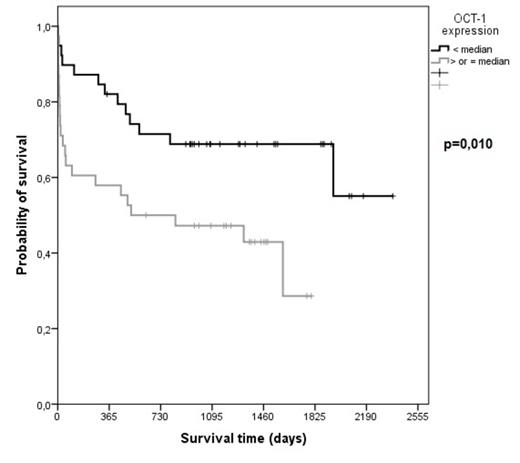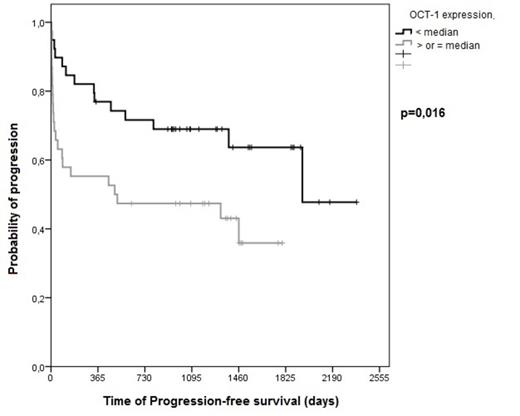Abstract
Background: Transcription factors associated with the POU domain modulate the expression of several genes of B lymphoid differentiation, including the IgH. The study of these factors allowed to better understand the pathogenesis of lymphomas and to establish the lineage and the differentiation stage of the malignant cell. The silencing of OCT1 in tumor cell lines reduced its malignant transformation, but its ectopic expression enhanced the tumorigenesis ability. However, few studies has been evaluated the role of the OCT1 gene expression in lymphoma. In this study we assessed the impact of the OCT1 gene expression in the survival of patients with Diffuse Large B Cell Lymphoma (DLBCL).
Methods: From January 2006 to January 2011 were evaluated 77 patients with DLBCL treated with R-CHOP at Clinical Hospital and Cancer Institute of Sao Paulo University. The RNA was extracted from the paraffin block at lymphoma diagnosis and gene expression analysis was performed by relative quantification method by Real-Time PCR (qRT-PCR). After the data normalization using two different reference genes, the median expression of OCT1 was obtained. The overall survival (OS) and progression-free survival (PFS) were estimated by the Kaplan-Meier method. The relative risks were obtained by Cox regression bivariate intervals with 95% of confidence. The significance level of 5% was accepted and the IBM SPSS Statistics software version 20.0 was used.
Results: Patients showing OCT1 expression < the median presented higher OS (p = 0.010) and PFS (p = 0.016) than patients with OCT1 expression ≥ median with a hazard rate (HR) for OS and PFS of 2.45 and 1.14, respectively. In multivariate analysis the PFS was also higher in patients with OCT1 expression < the median (p = 0.035). The stratification by the international prognostic index (IPI) and age showed that the expression of OCT1 < median showed a statistically significant difference in the OS (p = 0.048) in IPI intermediate-high (HI) and high (HR) patients (p = 0.048), with a HR of 2.32 in HI plus HR group. The PFS (p = 0.025) and OS (p = 0.025) were lower in patients ≥ 60 years and OCT1 expression ≥ the median.
Conclusion: Our data suggest that the expression of OCT1 showed a predictive prognostic impact in DLBCL independently of IPI. Patients with lower expression of OCT1 presented a better OS and PFS.
SG curve for the OCT1 gene expression.
SLP curve for the OCT1 gene expression.
SG curve for to expression of OCT1 gene for subgroup IPI intermediate-high and high.
SG curve for to expression of OCT1 gene for subgroup IPI intermediate-high and high.
No relevant conflicts of interest to declare.
Author notes
Asterisk with author names denotes non-ASH members.




This feature is available to Subscribers Only
Sign In or Create an Account Close Modal